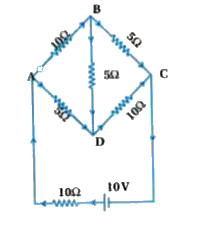At points P and Q, two identical charges each q are placed. When we move from P to Q (oa - the line joining them), electrostatic potential Solution in Gujrati
goes on decreasing
goes on increasing.
first goes on decreasing, then after becoming 1ninimum, it goes on increasing.
first increases, becomes maximum and then decreases.
The correct Answer is:A, B, C, D
becoming minimum, it goes on increasing.

Above figure shows the situation as per the statement.
Consider a point A on the line segment ¯¯¯¯¯¯PQ , at distance x from point P. Total electric potential at point A is,
V=V1+V2
=kqx+kqr−x
∴V=kq(1x+1r−x)
∴dVdx=kq[(−1x2)−1(r−x)2(−1)]
∴dVdx=kq[1(r−x)2−1x2]
Now taking dVdx=0 we get
0=kq[1(r−x)2−1x2]
∴1(r−x)2=1x2
∴x2=(r−x)2
∴x2=r2−2xr+x2
∴2xr=r2
∴x=r2
⇒Atx=r2V = max . OR V = min.
Now d2Vdx2=ddx(dVdx)
∴d2Vdx2=ddx[kq{1(r−x)2−1x2}]
=kq[−2(r−x)3(0−1)−(−2x3)]
∴d2Vdx2=2kq[1(r−x)3+1x3]
Now placing x = r2 in above equation
(d2Vdx2)atx=r2=2kq[8r3+8r3]
=32kqr3
>0
⇒Atx=r2 value of V is minimum.
Thus, as we move from P to C, potential goes on decreasing initially, then potential becomes minimum at mid point C and then potential goes on increasing.
Topper's Solved these Questions
- BOOK - KUMAR PRAKASHANCHAPTER - ELECTROSTATIC POTENTIAL AND CAPACITANCEEXERCISE - Section D ( MCQs asked in Cometitive Exams )39videos
ELECTROSTATIC POTENTIAL AND CAPACITANCE
- BOOK - KUMAR PRAKASHANCHAPTER - ELECTROSTATIC POTENTIAL AND CAPACITANCEEXERCISE - Section C ( NCERT Exemplar Solution ) ( Long Answer Type Questions )12videos
ELECTROSTATIC POTENTIAL AND CAPACITANCE
- BOOK - KUMAR PRAKASHANCHAPTER - ELECTROMAGNETIC WAVESEXERCISE - BOARD.S QUESTION PAPER MARCH - 2020 (PART - B) SECTION - C5videos
ELECTROMAGNETIC WAVES
- BOOK - KUMAR PRAKASHANCHAPTER - MAGNETISM AND MATTEREXERCISE - SECTION D Multiple Choice Questions (MCQs) (MCQs asked in Competitive Exams) MCQs asked in Board Exam and GUJCET7videos
MAGNETISM AND MATTER
Similar Questions
Capacitance of a capacitor 100 μ F. The work is done for depositing chargc 8×10−18 C on it will be .........
04:33View SolutionFind the equation of the equipotential for an infinite cylinder of radius r0 carrying charge of linear density λ.
05:51View SolutionDetermine the current in each branch of the given network.
 07:15View Solution
07:15View SolutionAt a place on earth the vertical component of earth's magnetic field is √3 times its horizontal component. The angle of dip at this place is …...
04:24View SolutionTwo identical charges +Q are kept fixed some distance apart.A small particles P with charge q is placed midway between them . If P is given a small displacement Delta ,it will undergo simple harmonic motion if (i) q is positive and Delta is along the line joining the charges (ii) q is positive and Delta is perpendicular to the line joining the charges (iii) q is negative and Delta is perpendicular to the line joining the charges (iv) q is positive and Delta is along the line joining the charges
View SolutionA charge Q is placed at the centre of the line joining two point charges +q and +q as shown in figure. The ratio of charges Q and q is
03:47View Solutionदो समान बिंदुवत आवेश Q जो परस्पर कुछ दूरी पर रखे गये हैं। को मिलाने वाली रेखा के मध्य में अन्य आवेश q रखा गया है। q का मान एवं प्रकृति ज्ञात कीजिए कि निकाय संतुलित रहे।
View SolutionTwo identical point charges'of magnitude -q are fixed as shown in the figure below. A third charge +q is placed midway between the two charges at the point P. Suppose this charge is displaced a small distance from the point P in the directions indicated by the arrows, in which direction(s) will +q be stable with respect to the displacement?
 03:41View Solution
03:41View SolutionA charge q is placed at the centre of the line joining two equal charges Q. The system of the three charges will be in equilibrium , if q is equal to
03:28View SolutionIf Two charges +qand+4p are separated by a distance .d. and a point Q is charge placed on the line joining the above two charges and in between them such that ali charges are in equilibrium. Then the charge Q and it.s position are
View SolutionA charge q is placed at the mid - point of the lien joining two charges each of Q. If the whole system is in equilibirum, then the value of q is
02:53View SolutionA charge Q is placed at the centre of the line joining two point charges +q and +q as shown in figure. The ratio of charges Q and q is
 03:43View Solution
03:43View SolutionA charge q is placed at the centre of the line joining two equal charges Q. the system of the three charges will be in equilibrium if q is equal to
04:54View SolutionIf two charges +q and +4q are separated by a distance 'd' and a point charge Q is placed on the line joining the above two charges and in between them such that all charges are in equilibrium. Then the charge Q and it's position are
03:37View SolutionA charge q is placed at the centre of the line joining two equal charges Q. The system of the three charges will be in equilibrium if q is equal to:
View Solution
